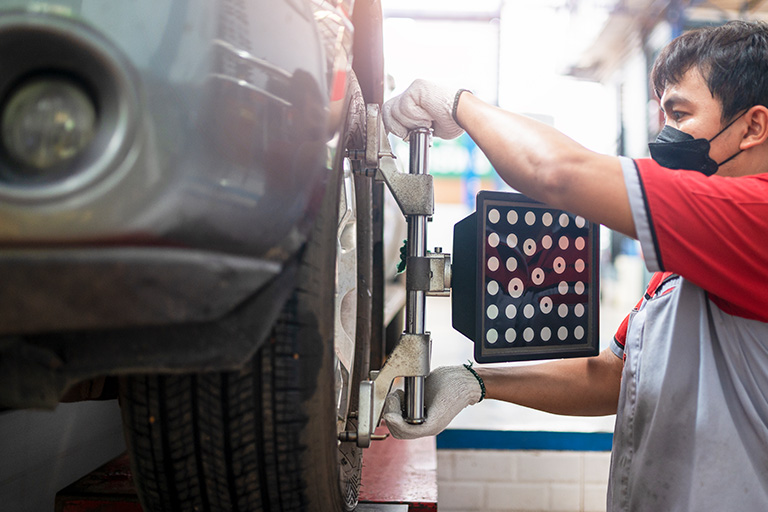Most drivers may not realize the impact that proper alignment has on their vehicle’s overall performance and safety. When your car’s wheels are not aligned correctly, it can lead to uneven tire wear, poor handling, and even a higher risk of accidents. This is why regularly checking and adjusting your car’s alignment is crucial for ensuring a smooth and safe driving experience. By understanding the importance of alignment and knowing how to check it, you can prevent costly repairs and maintain optimal driving conditions for your vehicle.
Key Takeaways:
- Regular inspection: It is important to regularly check your car’s alignment to ensure optimal performance and safety.
- Symptoms of misalignment: Look out for signs such as uneven tire wear, pulling to one side, or a crooked steering wheel which indicate a need for alignment adjustment.
- Professional evaluation: If you suspect alignment issues, take your car to a certified mechanic for a comprehensive inspection and correction to maintain proper vehicle handling.
Principles of Car Alignment
Understanding Camber, Caster, and Toe
Assuming proper alignment of your vehicle is important for optimal performance and safety. Understanding the three main components of alignment – camber, caster, and toe – is crucial. These factors determine how your tires make contact with the road, impacting handling, tire wear, and fuel efficiency.
How Alignment Affects Driving Performance
To achieve optimal driving performance, it is important to understand how alignment affects your vehicle. Caster angle refers to the steering axis’ tilt forward or backward. Improper caster alignment can result in unstable steering and uneven tire wear, leading to dangerous driving conditions.
It is crucial to regularly check and adjust your car’s alignment to ensure safe and optimal performance. Incorrect alignment can lead to accelerated tire wear, decreased fuel efficiency, and poor handling. By maintaining proper alignment, you can improve your vehicle’s overall driving experience and safety.
Symptoms of Misalignment
Clearly, understanding the symptoms of misalignment is crucial to maintaining the performance and safety of your vehicle. By recognizing the signs early on, you can address alignment issues promptly and prevent further damage to your car.
Irregular Tire Wear
On a visual inspection of your tires, if you notice uneven wear patterns or unusual bald spots, it may indicate misalignment. Uneven tire wear is a common and easily noticeable sign of alignment issues that should not be ignored.
Steering and Handling Problems
Tire misalignment can also manifest through steering and handling difficulties. For instance, if you find your car pulling to one side, experiencing vibration in the steering wheel, or having difficulty maintaining a straight path, it could be a symptom of misalignment. These issues can significantly impact your ability to control the vehicle, posing a safety hazard on the road.
Checking Your Car’s Alignment
DIY Alignment Checks
Not everyone is aware of the importance of having their car’s alignment checked regularly. With a few simple DIY alignment checks, you can ensure your vehicle is running smoothly and safely. Start by checking if your steering wheel is centered while driving straight and observing any pulling to one side.
Professional Alignment Services
Not all issues with your car’s alignment can be easily detected with a DIY check. On your car’s next service appointment, consider having a professional alignment service performed. This will involve specialized equipment and trained technicians who can precisely adjust your car’s alignment to manufacturer specifications.
Checks performed by professionals will ensure that your tires wear evenly, improving fuel efficiency and prolonging tire life. Ignoring alignment issues can lead to uneven tire wear, poor handling, and even dangerous driving conditions. Trusting experts to check and adjust your alignment can save you from costly repairs in the long run.
Maintaining Proper Alignment
Routine Maintenance Tips
Keep routine maintenance a top priority to ensure your car’s alignment stays in check. Regularly inspect your tires for signs of wear and tear, and make sure they are properly inflated. Additionally, have your alignment checked during your routine oil change to catch any issues early on.
- Inspect tires for wear and tear
- Ensure proper tire inflation
- Check alignment during oil change
- Thoroughly inspect steering and suspension components
Though proper alignment maintenance might seem tedious, it can save you from costly repairs and ensure a smoother driving experience in the long run.
When to Seek Professional Alignment
Alignment issues can arise due to various factors, such as rough roads, potholes, or even minor accidents. If you notice uneven tire wear, your vehicle pulling to one side, or the steering wheel off-center, it’s time to seek professional alignment services. Ignoring these signs can lead to further damage to your car’s suspension and steering components.
Another important point to note is that regular alignment checks are crucial to maintaining the overall health and performance of your vehicle. So, don’t hesitate to schedule a professional alignment service if you suspect any issues with your car’s alignment.
Conclusion
Considering all points discussed, it is crucial to understand and regularly check your car’s alignment to ensure optimal performance and safety on the road. Keeping your wheels properly aligned can prevent uneven tire wear, improve fuel efficiency, and enhance overall driving experience. By being proactive and attentive to your car’s alignment, you can avoid costly repairs and potential safety hazards. Regular alignment checks should be part of your routine maintenance schedule to extend the lifespan of your vehicle and ensure a smooth ride.
FAQ
Q: What is car alignment?
A: Car alignment refers to the adjustment of the angles of the wheels to ensure they are perpendicular to the ground and parallel to each other. Proper alignment is important for safe and efficient driving.
Q: Why is car alignment important?
A: Proper car alignment ensures that your vehicle handles correctly, reduces tire wear, improves fuel efficiency, and overall enhances the safety and performance of your car.
Q: How often should I check my car’s alignment?
A: It is recommended to have your car’s alignment checked at least once a year or if you experience any signs of poor alignment such as uneven tire wear, pulling to one side, or a crooked steering wheel.
What are the signs of poor car alignment?
A: Signs of poor car alignment include uneven or rapid tire wear, the steering wheel is off-center when driving straight, the vehicle pulls to one side, or you experience steering wheel vibration.
Can I check my car’s alignment myself?
A: While you can perform a basic alignment check at home by visually inspecting your tires for uneven wear, it is recommended to have a professional mechanic conduct a thorough alignment inspection using specialized equipment for accuracy.



